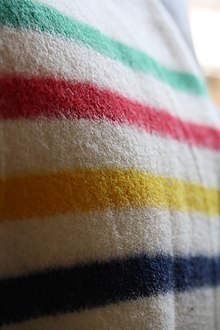Hudson's Bay point blanket

A Hudson's Bay point blanket is a type of wool blanket traded by the Hudson's Bay Company (HBC) in British North America (now Canada) and the United States during the 18th century and 19th century. The blankets were typically traded to First Nations and Native Americans in exchange for beaver pelts. The blankets continue to be sold by Canada's Hudson's Bay Company and have come to hold iconic status in Canada.
Importance to Native trade

In the North American fur trade, point blankets were one of the main European items sought by native peoples in exchange for beaver pelts, buffalo robes, pemmican, moccasins, and other trade goods. They were desired because of wool's ability to hold heat even when wet, and because they were easier to sew than bison or deer skins.
Wool cloth of one kind or another was traded as far back as the French regime in North America (1500-1765), but HBC point blankets were introduced in 1780 to compete with similar blankets offered by the Montreal-based private traders.[1] The blankets were often produced with a green stripe, red stripe, yellow stripe and indigo stripe on a white background; the four stripe colours were popular and easily produced using good colourfast dyes at that time.[2]
From the early days of the fur trade, point blankets were made into hooded coats called capotes by both natives and French Canadian voyageurs which were perfectly suited to Canada's cold winters.[3]

The value system
In the point system, the points - thin indigo lines - are woven into the blanket to denote its size and weight, such that it need not be unfolded and measured for those facts to be known. A common misconception is that each point indicated a quantity of beaver pelts or Hudson's Bay Company money. Blankets varied in colour, weight and design.
From the Hudson's Bay Company website:[4]
Each blanket was graded as to weight and size using a point system. Points were identified by the indigo lines woven into the side of each blanket. A full point measured 4 - 5.5 in.; a half point measured half that length. The standard measurements for a pair of 1 point blankets was: 2 ft. 8 in. wide by 8 ft. in length; with a weight of 3 lb. 1 oz. each. Points ranged from 1 to 6, increasing by halves depending upon the size and weight of the blanket. The number of points represented the overall finished size of the blanket, not its value in terms of beaver pelts as is sometimes believed.
Current use
Point blankets, made in England from 100% wool, are available at the Bay to the present day in three and a half-, four-, six-, and eight-point sizes corresponding respectively to a twin-, double-, queen-, or king-sized bed. Solid colours are available, as is the famous classic pattern featuring the green, red, yellow, and indigo stripes. Newly made blankets retail at between Cdn $275 and $475. Today the point blankets are made in England by John Atkinson, a sub brand of A.W. Hainsworth & Sons Ltd.[5]
The official licencee allowed to import Hudson's Bay Blankets into the United States is Woolrich Inc. out of Pennsylvania [6]
The coloured stripes appear on textile products by other manufacturers including some patterns on blankets made by Pendleton Woolen Mills.[7]
Collectability
Many early point blankets have survived into the 21st century and have become collectors items. The Oregon-based sculptor Marie Watt (part Seneca) has used point blankets in her sculpture work, which was exhibited in 2004 at the National Museum of the American Indian in Washington, D.C..
Nowadays genuine point blankets have become very collectible and could fetch prices up to thousands of dollars. The main determinants of value include age, size, colour, pattern rarity and condition. According to HBC Heritage Services, eBay is a good place to check current market values. Particularly collectible point blankets are the Coronation blankets; the one produced for the 1953 coronation of Queen Elizabeth II brings approximately $600 if in mint condition while examples of the even rarer, Coronation blanket dating to 1937 have sold for as high as $1300.
In 1890, HBC began adding labels to their blankets because point blankets of similar quality were being sold by HBC competitors from such manufacturers as Early's of Witney.[8]
Harold Lee Tichenor, point blanket collector and consultant to Hudson's Bay Company has written two books on point blankets and their collectibility: The Blanket: an Illustrated History of the Hudson's Bay Point Blanket (HBC, 2002) and A Collector's Guide to Point Blankets (Cinetel, 2003)
Name in First Nations languages
The Hudson's Bay blanket was called by different names in Native American languages. Some examples are:
- baahlaads gyaa'adaay, Haida language[9]
- p̓a̱lx̱a̱lasǥa̱m, (oo-haa-las-gam), Kwak'wala[10]
- ʔa·q̓unaq, (a-qhoo-nakh), Kutenai language[11]
References
- ^ http://www.pc.gc.ca/lhn-nhs/ab/rockymountain/natcul/natcul2/07.aspx
- ^ Greenbaum, Hilary (19 September 2011). "Who Made That Hudson's Bay Blanket?". The New York Times. Retrieved 29 September 2011.
- ^ the native canadian
- ^ Hudson's Bay Company website
- Note
- 4-5.5 in ≈ 100–140 mm
- 2 ft 8 in ≈ 810 mm
- 8 ft ≈ 2.4 m
- 3 lb 1 oz ≈ 1.4 kg
- ^ Interior Fabrics - Hainsworth Gems - About Hainsworth - Hainsworth
- ^ Hbc Heritage - FAQ
- ^ Pendleton Woolen Mills: GLACIER NATIONAL PARK BLANKET
- ^ http://web.archive.org/web/20110723155228/http://www.witneyblanketstory.org.uk/wbp.asp
- ^ "FirstVoices: Hlg̱aagilda X̱aayda Kil words". Retrieved 2012-07-10.
- ^ "FirstVoices: Kwak̓wala words". Retrieved 2012-07-10.
- ^ "FirstVoices: Ktunaxa words". Retrieved 2012-07-10.
External links
- Hbc Heritage - Our History - The Hbc Point Blanket
- The Witney Blanket Story - Archived comprehensive site about the Witney blanket industry, including manufacturers of Witney point blankets
- The Point Blanket Site - a basic introduction to the history of point blankets and information on dating and evaluation
